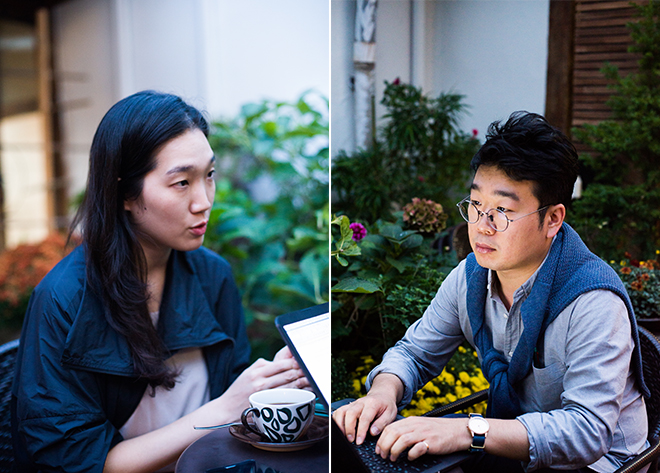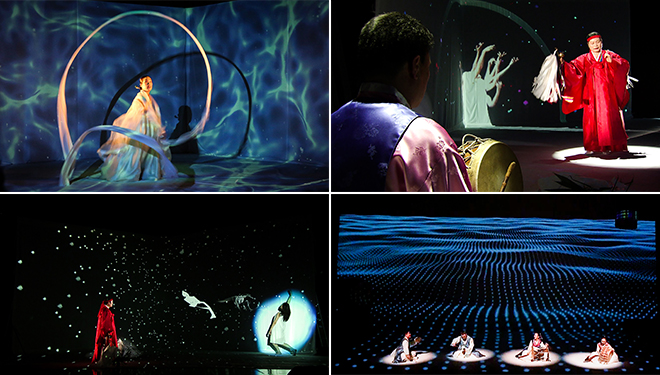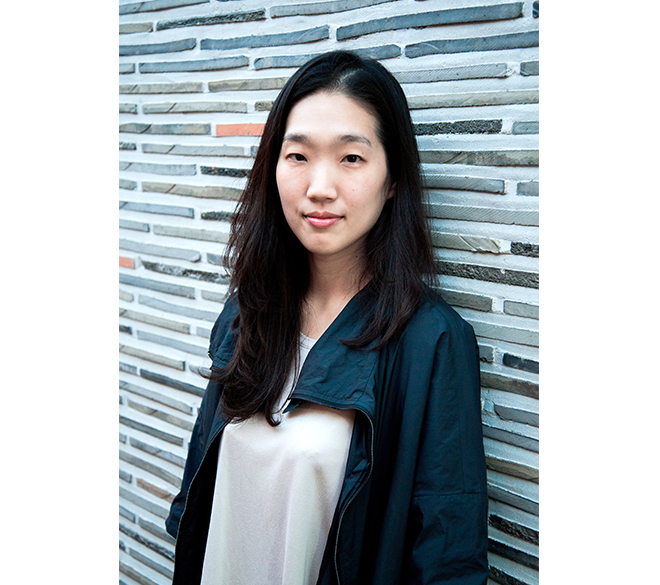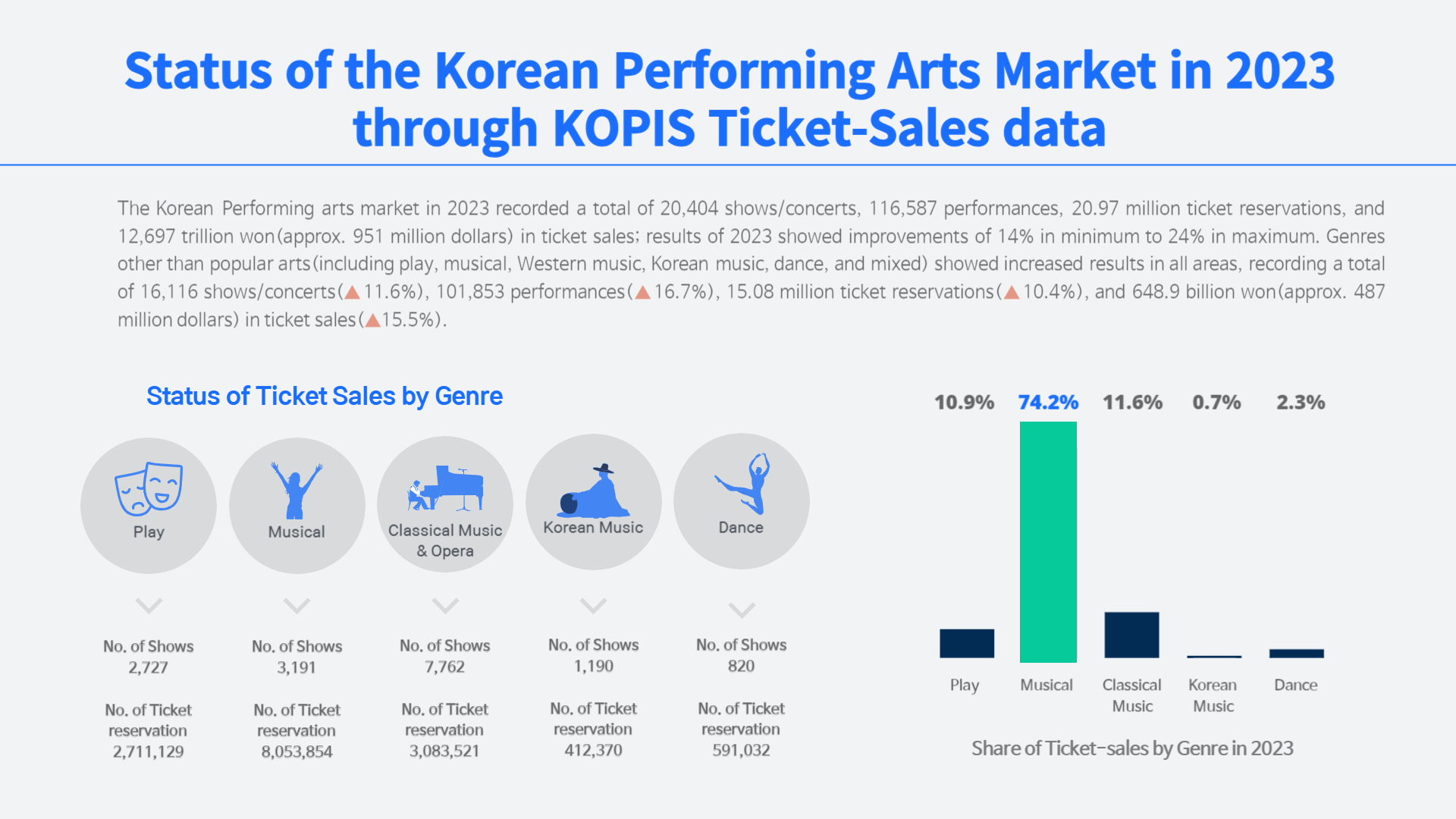Choreographer Song Haein links traditional gut with modern digital technology
|
| |
| ▲ Artistic director Song Haein (left) and the author (right) © Lee Kang-hyeok | |
Your work Miyeoji-Baengdi: Twilight Zone was selected for PAMS Choice as part of the 2016 Seoul Performing Arts Market, in the multidisciplinary performance category. Could you explain the work’s title?
In the dialect of Jejudo Island, miyeoji-baengdi refers to the time and space between the material world and the spiritual world.
Why did you choose this title in particular?
Well, the basis for the work is Jeju Keungut (Jeju Intangible Cultural Property No. 13), the great shamanic ritual of Jejudo Island. It’s a project four years in the making. A healing festivity like the gut seemed necessary; we live in a time of free, open communication, but people are still lonely.
Miyeoji-Baengdi: Twilight Zone was also a finalist in the 2015 Convergence Content Contest, organized by the Creative Center for Convergence Culture. What was behind your decision to blend gut with digital video technology?
In a way, miyeoji-baengdi, a place that exists but doesn’t, reminded me of the Internet, a virtual world created by light.
Song Haein, choreographer for Miyeoji-Baengdi: Twilight Zone, studied Korean dance at the Gugak National Middle and High School and went on to study choreography in the Department of Choreography at Korea National University of Arts. She is currently working toward a PhD in Contemporary and Digital Performance at Brunel University in London.
“The more I studied Korean dance, the more I became aware of the extent of the influence of Western dance. So I developed an interest in Korean dance’s original forms and rhythms, and around the same time, I happened to accompany chaesangsogochum master Kim Woon-tae to Jejudo Island. There I learned the shamanic ritual known as pungmul gut, as well as traditional singing. I also learned about the Jeju Keungut after joining Maro. The three months I’d spent thinking about these questions turned into three years of actual learning. These experiences in Jeju and my relationship with the members of Maro led me to create Miyeoji-Baengdi: Twilight Zone.”
Why digital video technology?
My works incorporate Korean dance, but oftentimes people assume what they’re seeing is a folk dance rather than something I’ve created. On the other hand, digital media is a global medium and isn’t as tied as folk culture is to a particular context. I felt digital technology could be used to help Jeju Keungut more effectively reach a wider audience.
What significance does Jejudo Island have for you?
When in Korea, I live and work on Jejudo Island. A lot of artists are hidden away there. The members of Maro live together in Pyoseon-myeon in the city of Seogwipo. You can see the ocean stretching out in front of you, and you feel the trees and the wind in a different way than you do on the mainland. I personally find that I concentrate much better in this environment. At Maro we do a lot of intensive research on traditional gut. We practice every day, and in the process we discover new things in the old traditions.
The theatrical qualities of gut, as well as its rhythms, often feature as motifs in creative productions. The Gyeonggido gut and Donghaean Byeolsingut are used often as source material. In Miyeoji-Baengdi: Twilight Zone, you draw from Jeju Keungut. What would you say are the defining characteristics of this gut?
It’s a robust gut. It goes on for two weeks, day and night. The Gyeonggi-do gut has an element of spectacle built into the music, and you can feel it as you’re dancing. In the Jeju Keungut, on the other hand, the melodies and the rhythms of the drums, gongs, and other instruments are all simple. The music is repetitive, as is what the shaman says and sings. As far as I know, it’s the best-preserved gut, truest to its original form. That is to say, it’s simpler and plainer and more concise than other gut (most of which have become increasingly elaborate over the course of transmission), yet it still packs quite a punch.
A gut is in many ways like a theatrical work. The shaman’s songs tell a story. What is the story in Miyeoji-Baengdi: Twilight Zone?
The Jeju Keungut is rich with mythological allusions. But as someone unfamiliar with the culture and dialect of Jejudo Island, I didn’t feel like I could just do what I wanted with it. The narrative follows the basic rites of the gut: the petitioning of the deity, the offering of the sacrifices, the chasing away of the evil spirits (or pudakgeori), and so on. Miyeoji-Baengdi: Twilight Zone focuses on just one person conducting these rituals. It would be nice to invite audience members to participate, but there are always limitations with a proscenium stage.
Would you say gut have happy endings?
Of course. Misfortune and suffering are dispelled, and evil chased away.
|
| |
| ▲ Miyeoji-Baengdi: Twilight Zone © Maro | |
In 2013, Song Haein and the other members of Maro unveiled Leodo: Paradise Lost. Inspired by the Jeju Keungut and the tale of the mythical island Leodo, the production was featured at the Edinburgh Fringe Festival for three years.
“When someone is lost at sea, the people of Jejudo don’t believe he’s died; they believe he’s living happily on the island of Leodo. The island is a resting place for such people.”
Miyeoji-Baengdi, the space between the material and spiritual worlds. Leodo Island, a resting place. Both of these works depict places of utter and inevitable unfamiliarity. Place seems to have an important meaning to her, figuring in her work almost as a character in itself.
“Augmented reality, virtual reality—we live in a world of multiple realities. People in modern society create and manipulate these realities, while shamans enter a separate space and time to bring release from pain and suffering. In certain ways, the two have a lot in common.”
A gut is a comprehensive art form, a combination of singing, dancing, and musical performance. Digital mapping and interactive technology are also comprehensive in a sense, combining visual and aural elements. Was it difficult trying to bring these forms together?
Digital technology features in certain parts of Miyeoji-Baengdi: Twilight Zone as a component of gut. A gut involves the use of shamanic props: in this case, the gime, a paper ornament made in the shape of a human, and the donggyeong (also known as myeongdo), the round brass mirror that shamans regard as the face of the deity they worship. In the Jeju Keungut, these props symbolize heaven and earth. I felt it would be possible to use digital technology in the same way, as a shamanic prop used in gut. I incorporated it in a general way, though, so the elements wouldn’t clash. Still, if you’re deeply rooted in tradition, you can’t help but be cautious about accepting these kinds of new ideas. I was cautious too, and [our team] needed time to understand one another.
Recently, young people have become the main agents in the transmission of gut. As carried out by these young people, who on the whole are well versed in the language of cross-convergence, gut has been combined with other genres and staged in experimental works. These works are made especially powerful and significant by the willingness of veteran performers, some of them teachers to the new performers, to participate. In Miyeoji-Baengdi: Twilight Zone, too, the Jeju shaman Seo Sun Sil performs alongside Song Haein.
“To be honest, I did have concerns that our project might in some way offend the master shaman, but she is deeply committed to bringing Jeju Keungut to more people, so she was open-minded in providing assistance.”
Miyeoji-Baengdi: Twilight Zone will be presented at PAMS Choice in a thirty-minute showcase. What outcomes are you looking forward to seeing?
As I immersed myself in Jeju Keungut, I realized that in some ways it would be harder to reach people on the mainland—that is, in Seoul—than people outside of Korea. There’s a prejudice against art organizations from Jejudo Island. This is one reason why we chose to go abroad, to the Edinburgh Fringe Festival, for example. The piece is sixty minutes long, but we have thirty minutes to perform. I was born and raised in Seoul, but this is my first performance in Seoul. In connection with this performance, I want to look into festivals that would be interested in a production like Miyeoji-Baengdi: Twilight Zone and be a good fit. Our first time at the Edinburgh Fringe Festival, we deliberated about whether we should be categorized as dance or song. So it would be nice to be connected with festivals or directors who are interested in this kind of genre. When we performed Leodo: Paradise Lost internationally, I got the strong impression that our foreign audiences didn’t have any prejudices about Korean gut. They just accepted it for what it was.
|
| |
| ▲ Choreographer and artistic director Song Haein © Lee Kang-hyeok | |
What are your plans after PAMS?
I have a lot of interest in psychological healing for people in our modern society. I’m thinking of combining gut with art therapy, which I learned about in London. The two forms have a lot in common with respect to healing. A lot of people become shamans because they believe and accept that this is their destiny; it turns out the same is true for a lot of therapists. In November, Maro will perform a Jeju Keungut with shaman Seo Sun-sil at the School of Oriental and African Studies in London, followed by a discussion with the audience. Another project coming up has to do with exchanges between artists in Korea and the UK. I’ll be doing research for an upcoming project with Roddy Skeaping, the sound designer. He’s a therapist as well. If all goes well, we might do a joint performance.











 PREV
PREV

.jpg)
.jpg)
.jpg)
.jpg)











